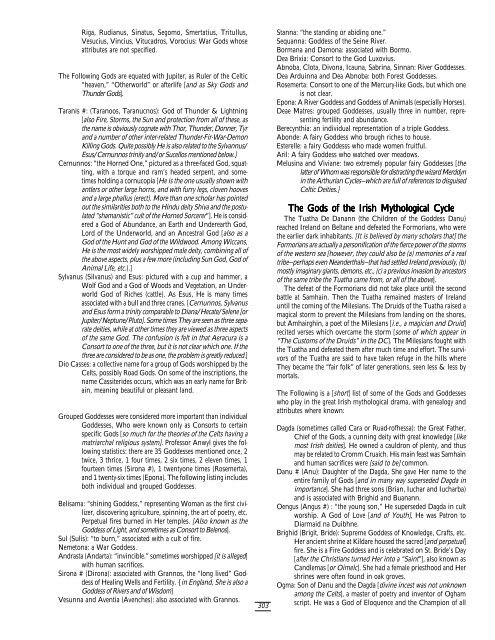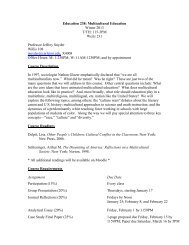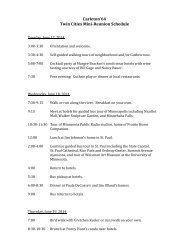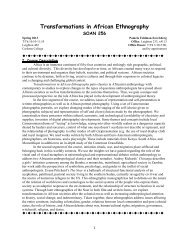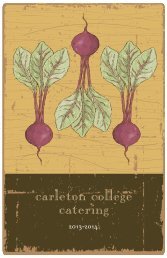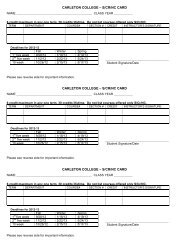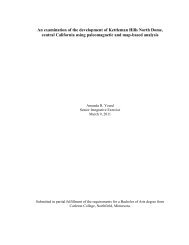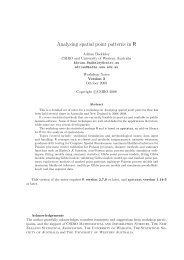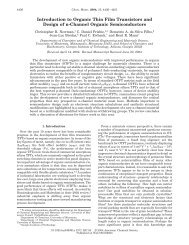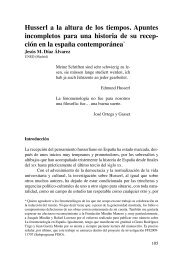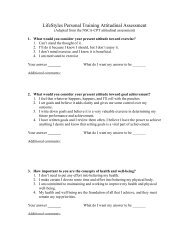babababababababababababababab the druid ... - Carleton College
babababababababababababababab the druid ... - Carleton College
babababababababababababababab the druid ... - Carleton College
You also want an ePaper? Increase the reach of your titles
YUMPU automatically turns print PDFs into web optimized ePapers that Google loves.
Riga, Rudianus, Sinatus, Segomo, Smertatius, Tritullus,<br />
Vesucius, Vincius, Vitucadros, Vorocius: War Gods whose<br />
attributes are not specified.<br />
The Following Gods are equated with Jupiter, as Ruler of <strong>the</strong> Celtic<br />
“heaven,” “O<strong>the</strong>rworld” or afterlife [and as Sky Gods and<br />
Thunder Gods].<br />
Taranis #: (Taranoos, Taranucnos): God of Thunder & Lightning<br />
[also Fire, Storms, <strong>the</strong> Sun and protection from all of <strong>the</strong>se, as<br />
<strong>the</strong> name is obviously cognate with Thor, Thunder, Donner, Tyr<br />
and a number of o<strong>the</strong>r inter-related Thunder-Fir-War-Demon<br />
Killing Gods. Quite possibly He is also related to <strong>the</strong> Sylvannus/<br />
Esus/Cernunnos trinity and/or Sucellos mentioned below.]<br />
Cernunnos: “<strong>the</strong> Horned One,” pictured as a three-faced God, squatting,<br />
with a torque and ram’s headed serpent, and sometimes<br />
holding a cornucopia [He is <strong>the</strong> one usually shown with<br />
antlers or o<strong>the</strong>r large horns, and with furry legs, cloven hooves<br />
and a large phallus (erect). More than one scholar has pointed<br />
out <strong>the</strong> similarities both to <strong>the</strong> Hindu deity Shiva and <strong>the</strong> postulated<br />
“shamanistic” cult of <strong>the</strong> Horned Sorcerer”]. He is considered<br />
a God of Abundance, an Earth and Underearth God,<br />
Lord of <strong>the</strong> Underworld, and an Ancestral God [also as a<br />
God of <strong>the</strong> Hunt and God of <strong>the</strong> Wildwood. Among Wiccans,<br />
He is <strong>the</strong> most widely worshipped male deity, combining all of<br />
<strong>the</strong> above aspects, plus a few more (including Sun God, God of<br />
Animal Life, etc.).]<br />
Sylvanus (Silvanus) and Esus: pictured with a cup and hammer, a<br />
Wolf God and a God of Woods and Vegetation, an Underworld<br />
God of Riches (cattle). As Esus, He is many times<br />
associated with a bull and three cranes. [Cernunnos, Sylvanus<br />
and Esus form a trinity comparable to Diana/Hecate/Selene [or<br />
Jupiter/Neptune/Pluto]. Some times They are seen as three separate<br />
deities, while at o<strong>the</strong>r times <strong>the</strong>y are viewed as three aspects<br />
of <strong>the</strong> same God. The confusion is felt in that Aeracura is a<br />
Consort to one of <strong>the</strong> three, but it is not clear which one. If <strong>the</strong><br />
three are considered to be as one, <strong>the</strong> problem is greatly reduced.]<br />
Dio Casses: a collective name for a group of Gods worshipped by <strong>the</strong><br />
Celts, possibly Road Gods. On some of <strong>the</strong> inscriptions, <strong>the</strong><br />
name Cassiterides occurs, which was an early name for Britain,<br />
meaning beautiful or pleasant land.<br />
Grouped Goddesses were considered more important than individual<br />
Goddesses, Who were known only as Consorts to certain<br />
specific Gods [so much for <strong>the</strong> <strong>the</strong>ories of <strong>the</strong> Celts having a<br />
matriarchal religious system]. Professor Anwyl gives <strong>the</strong> following<br />
statistics: <strong>the</strong>re are 35 Goddesses mentioned once, 2<br />
twice, 3 thrice, 1 four times, 2 six times, 2 eleven times, 1<br />
fourteen times (Sirona #), 1 twentyone times (Rosemerta),<br />
and 1 twenty-six times (Epona). The following listing includes<br />
both individual and grouped Goddesses.<br />
Belisama: “shining Goddess,” representing Woman as <strong>the</strong> first civilizer,<br />
discovering agriculture, spinning, <strong>the</strong> art of poetry, etc.<br />
Perpetual fires burned in Her temples. [Also known as <strong>the</strong><br />
Goddess of Light, and sometimes as Consort to Belenos].<br />
Sul (Sulis): “to burn,” associated with a cult of fire.<br />
Nemetona: a War Goddess.<br />
Andrasta (Andarta): “invincible.” sometimes worshipped [it is alleged]<br />
with human sacrifices.<br />
Sirona # (Dirona): associated with Grannos, <strong>the</strong> “long lived” Goddess<br />
of Healing Wells and Fertility. {in England, She is also a<br />
Goddess of Rivers and of Wisdom]<br />
Vesunna and Aventia (Avenches): also associated with Grannos.<br />
303<br />
Stanna: “<strong>the</strong> standing or abiding one.”<br />
Sequanna: Goddess of <strong>the</strong> Seine River.<br />
Bormana and Damona: associated with Bormo.<br />
Dea Brixia: Consort to <strong>the</strong> God Luxovius.<br />
Abnoba, Clota, Divona, Icauna, Sabrina, Sinnan: River Goddesses.<br />
Dea Arduinna and Dea Abnoba: both Forest Goddesses.<br />
Rosemerta: Consort to one of <strong>the</strong> Mercury-like Gods, but which one<br />
is not clear.<br />
Epona: A River Goddess and Goddess of Animals (especially Horses).<br />
Deae Matres: grouped Goddesses, usually three in number, representing<br />
fertility and abundance.<br />
Berecynthia: an individual representation of a triple Goddess.<br />
Abonde: A fairy Goddess who brough riches to house.<br />
Esterelle: a fairy Goddesss who made women fruitful.<br />
Aril: A fairy Goddess who watched over meadows.<br />
Melusina and Viviane: two extremely popular fairy Goddesses [<strong>the</strong><br />
latter of Whom was responsible for distracting <strong>the</strong> wizard Merddyn<br />
in <strong>the</strong> Arthurian Cycles—which are full of references to disguised<br />
Celtic Deities.]<br />
The The Gods Gods of of <strong>the</strong> <strong>the</strong> Irish Irish Mythological Mythological Cycle<br />
Cycle<br />
The Tuatha De Danann (<strong>the</strong> Children of <strong>the</strong> Goddess Danu)<br />
reached Ireland on Beltane and defeated <strong>the</strong> Formorians, who were<br />
<strong>the</strong> earlier dark inhabitants. [It is believed by many scholars that] <strong>the</strong><br />
Formorians are actually a personification of <strong>the</strong> fierce power of <strong>the</strong> storms<br />
of <strong>the</strong> western sea [however, <strong>the</strong>y could also be (a) memories of a real<br />
tribe—perhaps even Neanderthals—that had settled Ireland previously, (b)<br />
mostly imaginary giants, demons, etc., (c) a previous invasion by ancestors<br />
of <strong>the</strong> same tribe <strong>the</strong> Tuatha came from, or all of <strong>the</strong> above].<br />
The defeat of <strong>the</strong> Formorians did not take place until <strong>the</strong> second<br />
battle at Samhain. Then <strong>the</strong> Tuatha remained masters of Ireland<br />
until <strong>the</strong> coming of <strong>the</strong> Milesians. The Druids of <strong>the</strong> Tuatha raised a<br />
magical storm to prevent <strong>the</strong> Milesians from landing on <strong>the</strong> shores,<br />
but Amhairghin, a poet of <strong>the</strong> Milesians [i.e., a magician and Druid]<br />
recited verses which overcame <strong>the</strong> storm [some of which appear in<br />
“The Customs of <strong>the</strong> Druids” in <strong>the</strong> DC]. The Milesians fought with<br />
<strong>the</strong> Tuatha and defeated <strong>the</strong>m after much time and effort. The survivors<br />
of <strong>the</strong> Tuatha are said to have taken refuge in <strong>the</strong> hills where<br />
They became <strong>the</strong> “fair folk” of later generations, seen less & less by<br />
mortals.<br />
The Following is a [short] list of some of <strong>the</strong> Gods and Goddesses<br />
who play in <strong>the</strong> great Irish mythological drama, with genealogy and<br />
attributes where known:<br />
Dagda (sometimes called Cara or Ruad-rofhessa): <strong>the</strong> Great Fa<strong>the</strong>r,<br />
Chief of <strong>the</strong> Gods, a cunning deity with great knowledge [like<br />
most Irish deities]. He owned a cauldron of plenty, and thus<br />
may be related to Cromm Cruaich. His main feast was Samhain<br />
and human sacrifices were [said to be] common.<br />
Danu # (Anu): Daughter of <strong>the</strong> Dagda, She gave Her name to <strong>the</strong><br />
entire family of Gods [and in many way superseded Dagda in<br />
importance]. She had three sons (Brian, Iuchar and Iucharba)<br />
and is associated with Brighid and Buanann.<br />
Oengus (Angus #) : “<strong>the</strong> young son,” He superseded Dagda in cult<br />
worship. A God of Love [and of Youth], He was Patron to<br />
Diarmaid na Duibhne.<br />
Brighid (Brigit, Bride): Supreme Goddess of Knowledge, Crafts, etc.<br />
Her ancient shrine at Kildare housed <strong>the</strong> sacred [and perpetual]<br />
fire. She is a Fire Goddess and is celebrated on St. Bride’s Day<br />
[after <strong>the</strong> Christians turned Her into a “Saint”], also known as<br />
Candlemas [or Oimelc]. She had a female priesthood and Her<br />
shrines were often found in oak groves.<br />
Ogma: Son of Danu and <strong>the</strong> Dagda [divine incest was not unknown<br />
among <strong>the</strong> Celts], a master of poetry and inventor of Ogham<br />
script. He was a God of Eloquence and <strong>the</strong> Champion of all


